This savory Carne Para Pasteles (Pork Filling) recipe used for Puerto Rican Pasteles is filled with delicious spices, is easy to make and comes together in an hour. Every bite is a true celebration of flavor marked with a taste of the season’s festivities!

At any Puerto Rican holiday feast, you can expect to find beloved classics like Pernil, Arroz con Gandules, Ensalada de Coditos, and Ensalada de Papa. But the true sign of the holiday spirit, the dish that unequivocally signals the arrival of festivities, is of course Puerto Rican Pasteles.
While Pasteles de Guineo takes the lead as the go-to choice during the holidays, some families also whip up Pasteles de Yuca, Pasteles de Arroz and Empanadas de Yuca. Yet, regardless of the type, they all share a common denominator – a tantalizing meat filling. Though pork is the timeless favorite, this recipe seamlessly adapts to chicken. Just dice your chosen meat, infuse it with a medley of spices, and let it simmer on the stove for an hour. And before you know it – your perfect pasteles filling will be ready to complement your pasteles masa!
Jump to:
REASONS TO LOVE THIS MEAT FILLING
- Versatile: This recipe can be used for both a pork and chicken filling.
- Easy Access to Seasonings: Most of the seasonings used in this recipe we already have in our Latin pantry or can gain easy access to. Seasonings like oregano, garlic, vinegar, adobo, etc are usually available to us.
- Simple Preparation: After cubing the meat, combine all the seasonings in a pot and let them simmer—a recipe that’s akin to “set it and forget it.”
- Shared Traditions: Making the meat filling for pasteles often involves following family recipes or cultural traditions, turning it into a meaningful and shared experience. Whether passed down through generations or shared with loved ones in the kitchen, the process fosters a sense of connection and nostalgia, making each batch of pasteles a celebration of heritage.
Ingredients

- Pork – Use pork shoulder or butt.
- Garlic – Use fresh garlic or garlic puree for the best flavor.
- Oregano and Bay Leaves – Both are very important aromatic ingredients to this filling.
- Sazon – Use sazon with annatto for both flavor and color.
- Adobo and Sofrito – Adds both seasoning and true authentic Puerto Rican flavor.
- Garbanzo Beans (Chickpeas) – Usually used in the pasteles filling but excluded from the empanadas de yuca filling.
- Pimiento Morrones (Roasted Red Bell Peppers) – An ingredient I couldn’t imagine not using in my meat filling!
- Achiote Oil (Annatto Oil) – adds flavor and color to the meat.
See my recipe card below for a complete list of the ingredients with measurements.
Substitutions and Variations
- Meat Filling: Use chicken if you do not eat pork.
- Roasted Peppers: I buy a jar of pimiento morrones but you can also roast a red bell pepper in the oven until charred, cover to allow the pepper to sweat, peel other skin, and then cut into strips.
- Olives: Use pimiento-stuffed olives or exclude them if you do not like them.
- Raisins: Some families like to add raisins to their meat filling, for added texture and flavor. I do not like raisins in my pasteles so I do not use them but of course, feel free to use them in yours.
- Chick Peas: Chick peas or garbanzo beans are traditionally only used in the meat filling for pasteles de guineo and pasteles de yuca but not in empanadas de yuca. However, remember, you’re the master of your kitchen, if you love chick peas, use them in the empanada filling too!
- Meatless: You can also make this meat filling “vegetarian” by excluding the meat completely and adding more potatoes, chickpeas and other veggies like bell peppers and onions.
Instructions

Step 1: Rinse the pork and then cut into ½ inch cubes.

Step 2: Add the pork to a mixing bowl and top with a generous amount of adobo and garlic powder.

Step 3: Incorporate the seasoning well and allow the pork to sit for a few minutes.

Step 4: In a caldero or other large pot, add the achiote oil and heat over medium heat.

Step 5: Add the pork and cook for a few minutes.

Step 6: Add the seasonings, olives, tomato sauce and pimiento peppers and the water. Stir.
Cook for 40 minutes.

Step 7: Add the potatoes, chickpeas, cilantro and stir. Cook for an additional 20, or 30 minutes or until the pork is fork tender.

Step 8: After an hour the pork should be perfectly tender and brothy.

Expert Cooking Tips
- Cooking Time – Cook the meat for an hour or until fork tender. The meat should be very tender when adding it to the masa.
- Broth – If you observe the broth in the pot beginning to reduce, simply incorporate an additional cup of water to maintain enough liquid in the meat as you will need a few cups of broth for the pasteles masa.
- Oil – Do not skim the extra oil that forms in the top of the pot. This oil is used in the preparation of pasteles as well.
- Smoked Ham Steak, ham bouillon – Adding cubed ham or bouillon to the meat is optional, please note I didn’t use it in this recipe.
- Salt – Please note, that I didn’t use salt in this recipe as I find that between the seasoned pork, sazon, and chicken bouillon, it is not needed. However, this is a personal preference, taste the pork at the end of the cooking process and add salt if desired.
Recipe FAQs
Yes! You can use dark chicken or chicken breast.
Absolutely! Use potatoes, chickpeas, onions, bell peppers and carrots.
You can make this recipe up to 3 days in advance if making pasteles within that timeframe.
Yes! This is the same filling used for both except for the empanadas de yuca, we traditionally exclude the chickpeas.
Absolutely! Freeze in a freezer safe container or bags for up to two months.
Store this filling for up to four days.
Did you try this recipe? Please leave a ⭐ review below!
Click any of the images in the post to PIN this Recipe and don’t forget to follow along on Pinterest and Facebook.
Other Traditional Holiday Dishes You Will Love
📖 Recipe

Carne para Pasteles (Pork Filling)
Ingredients
- 3 lbs pork shoulder or boston butt rinsed and cut into ½ inch cubes.
- 1 cup smoked ham cubed (optional)
- 3 tablespoon garlic puree or whole cloves minced
- adobo sprinkled
- garlic powder sprinkled
- ⅛ teaspoon cumin
- 1 packet sazon with annatto
- 2 tablespoon oregano
- ½ tsp pepper
- 2 cubes chicken bouillon
- 1 packet ham bouillon optional
- 1-2 bay leaves
- 4 tablespoon sofrito
- ½ cup tomato sauce
- 1 potato cubed
- 1 can chickpeas drained
- ¾ cup olives plus ¼ cup of the brine
- 2 whole pimiento peppers (pimientos morrones)
- 7 tablespoon achiote oil
- handful cilantro rinsed and roughly chopped
- 2 cups water
Instructions
- Rinse the pork and then cut into ½ inch cubes.
- Add the pork to a mixing bowl and top with a generous amount of adobo and garlic powder.
- Incorporate the seasoning well and allow the pork to sit for a few minutes.
- In a caldero or other large pot, add the achiote oil and heat over medium heat.
- Add the pork and cook for a few minutes just until some of the pieces start to turn color.
- Add the oregano, bouillon, pepper, cumin, garlic, bay leaves, olives plus ¼ cup of the brine, sazon, sofrito, tomato sauce, pimiento peppers and the water. Stir.Cook for 40 minutes.
- Add the potatoes, chickpeas, cilantro and stir. Cook for an additional 20, 30 minutes or until the pork is fork tender.
Notes
Nutrition


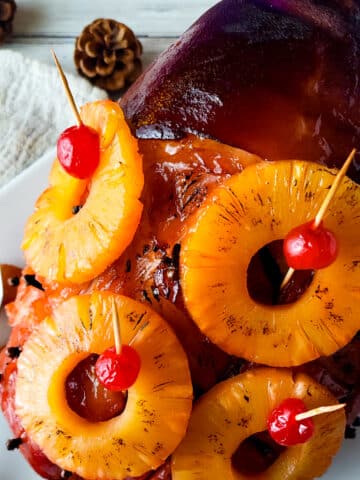

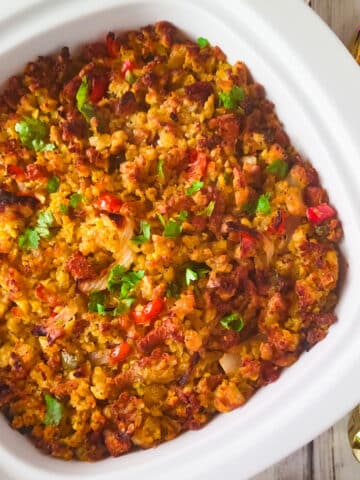
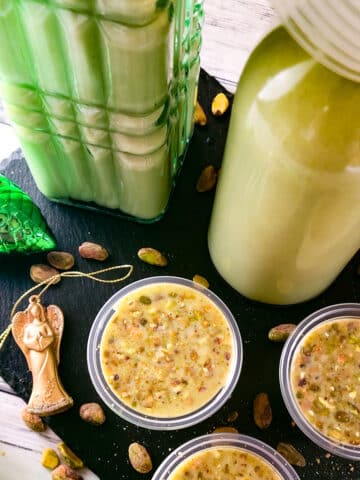
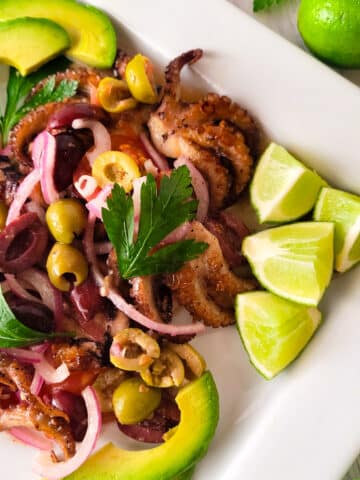
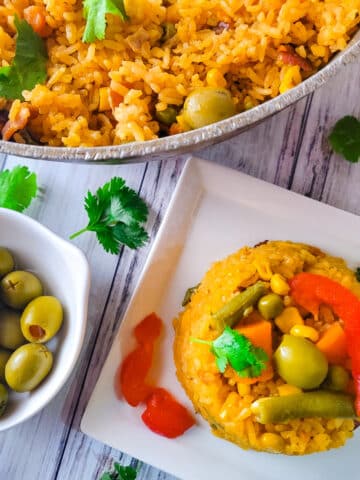



Shelley Frankel says
Love all the recipes. Measurements are foolproof. Just had delicious black beans with homemade sofrito and white rice.
Thank You Cathy!
Your loyal American Cook,
Shelley Frankel
Catherine Arena says
Thank you so much Shelley! I’m humbled by your sweet comment!🥰 Would love some black beans and rice right now! Thank you again and thank you for taking the time to comment and star rating!